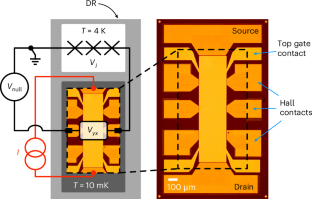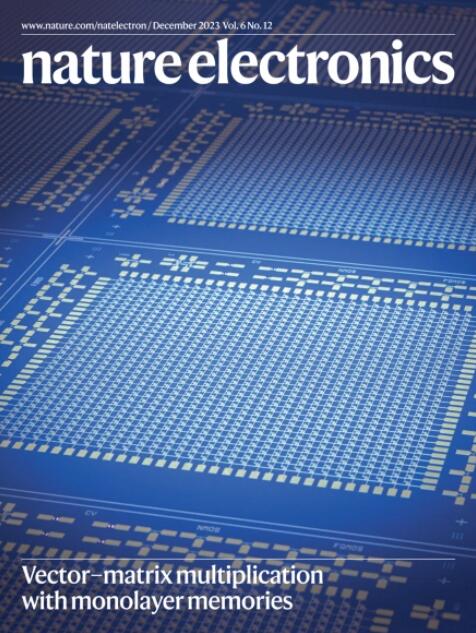从量子国际单位制统一实现的电量
IF 40.9
1区 工程技术
Q1 ENGINEERING, ELECTRICAL & ELECTRONIC
引用次数: 0
摘要
在修订后的国际单位制(SI)中,欧姆和伏特是由冯·克里琴常数和约瑟夫森常数实现的,而安培则是通过将欧姆定律直接应用于量子霍尔和约瑟夫森效应而实现的。因此,有可能创造一种能够实现所有三个主要电气单元的仪器,但这种系统的开发仍然具有挑战性。在这里,我们报告了通过将量子异常霍尔电阻器(QAHR)和可编程约瑟夫森电压标准(PJVS)集成在单个低温恒温器中统一实现伏特,欧姆和安培。该系统的量子电压输出范围为0.24 mV ~ 6.5 mV,综合相对不确定度低至3 μV V−1。QAHR提供了零磁场下欧姆的实现,不确定度接近1 μΩ Ω−1。我们使用QAHR将纵向电流转换为量子化的霍尔电压,然后直接将其与PJVS进行比较以实现安培。我们在9.33-252 nA范围内测量电流,在83.9 nA时,我们的最低不确定度为4.3 μA A−1。对于其他电流值,由于不完全隔离PJVS微波偏置,存在−10 μA a−1至−30 μA a−1的系统误差。本文章由计算机程序翻译,如有差异,请以英文原文为准。


A unified realization of electrical quantities from the quantum International System of Units
In the revised International System of Units (SI), the ohm and the volt are realized from the von Klitzing constant and the Josephson constant, and a practical realization of the ampere is possible by applying Ohm’s law directly to the quantum Hall and Josephson effects. As a result, it is possible to create an instrument capable of realizing all three primary electrical units, but the development of such a system remains challenging. Here we report a unified realization of the volt, ohm and ampere by integrating a quantum anomalous Hall resistor (QAHR) and a programmable Josephson voltage standard (PJVS) in a single cryostat. Our system has a quantum voltage output that ranges from 0.24 mV to 6.5 mV with combined relative uncertainties down to 3 μV V−1. The QAHR provides a realization of the ohm at zero magnetic field with uncertainties near 1 μΩ Ω−1. We use the QAHR to convert a longitudinal current to a quantized Hall voltage and then directly compare that against the PJVS to realize the ampere. We determine currents in the range of 9.33–252 nA, and our lowest uncertainty is 4.3 μA A−1 at 83.9 nA. For other current values, a systematic error that ranges from −10 μA A−1 to −30 μA A−1 is present due to the imperfect isolation of the PJVS microwave bias. A unified realization of the volt, ohm and ampere can be achieved by integrating a quantum anomalous Hall resistor and a programmable Josephson voltage standard in a single cryostat.
求助全文
通过发布文献求助,成功后即可免费获取论文全文。
去求助
来源期刊

Nature Electronics
Engineering-Electrical and Electronic Engineering
CiteScore
47.50
自引率
2.30%
发文量
159
期刊介绍:
Nature Electronics is a comprehensive journal that publishes both fundamental and applied research in the field of electronics. It encompasses a wide range of topics, including the study of new phenomena and devices, the design and construction of electronic circuits, and the practical applications of electronics. In addition, the journal explores the commercial and industrial aspects of electronics research.
The primary focus of Nature Electronics is on the development of technology and its potential impact on society. The journal incorporates the contributions of scientists, engineers, and industry professionals, offering a platform for their research findings. Moreover, Nature Electronics provides insightful commentary, thorough reviews, and analysis of the key issues that shape the field, as well as the technologies that are reshaping society.
Like all journals within the prestigious Nature brand, Nature Electronics upholds the highest standards of quality. It maintains a dedicated team of professional editors and follows a fair and rigorous peer-review process. The journal also ensures impeccable copy-editing and production, enabling swift publication. Additionally, Nature Electronics prides itself on its editorial independence, ensuring unbiased and impartial reporting.
In summary, Nature Electronics is a leading journal that publishes cutting-edge research in electronics. With its multidisciplinary approach and commitment to excellence, the journal serves as a valuable resource for scientists, engineers, and industry professionals seeking to stay at the forefront of advancements in the field.
 求助内容:
求助内容: 应助结果提醒方式:
应助结果提醒方式:


